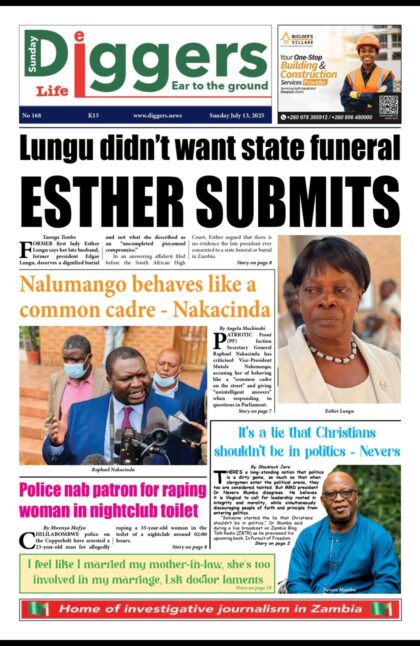Minister of Transport and Communication Eng. Brian Mushimba says government will not withdraw or revise Statutory Instrument number 7 of 2018 which is ordering a 30 per cent transfer of all goods in transit from road to railway, saying stakeholders who are complaining like Chamber of Mines were extensively consulted.
And Eng. Mushimba says where transporters of goods will find no railway infrastructure in place, they will have to offload the cargo and move it by road to the next railway facility.
Earlier this week, the Chamber of Mines (ZCM) said every single mining company in Zambia would opt to use rail transport if it made good business sense, but the available infrastructure defeats logic.
But responding to ZCM, Mushimba said the available railway infrastructure was enough to support 30 per cent of the cargo which is being moved by road, adding that the Chamber was consulted over the matter.
“The first consultative meeting with the Zambia Chamber of Mines was held in March 15, 2017. However, the Zambia Chamber of Mines requested that we hold another consultative meeting with its members. As per request, another consultative meeting was held in Kitwe on May 29, 2017 with the mining companies and other key stakeholders. All of these meetings provided government with huge amounts of valuable feedback. The feedback and submissions received helped us in identifying some refinements to the SI and its implementation methodology,” Eng. Musgimba said.
He went further to respond to the concerns by the Chamber of Mines.
“[On the question of] Poor state of the permanent way and inadequate capacity of the railway infrastructure on the Copperbelt Province, the implementation of the SI will be undertaken in line with the capacity of the railway sector in Zambia. Currently over 30 percent of the market share can be accommodated by railway infrastructure capacity. It is worthy to note that immediately the government took over the management of Zambia Railways Limited from the concessionaires, it revived the company operations on the inter-mine. Zambia Railways Limited serviced and made ready the operations of various inter-mine lines,” Mushimba said.
“The company also repaired all the branch lines (Luano-Chililabombwe, Nkana- Chingola, among others and reconstructed railway linkages in Nchanga and Konkola plants for KCM. Through joint funding arrangements with customers, Zambia Railways Limited linked new mines and industries such as Chambishi Copper Smelters, Bridge Shipping, Manica, Zambia Furnance Supplies and among others by rail. Full rehabilitation of the railway infrastructure (including the inter-mine) to accommodate speed of up to 120km/h is part of government’s plan. At the moment government is in discussion with possible financiers to finance full track rehabilitation including the inter-mine.”
He said where transporters would not find railway infrastructure in place, they will have to move their cargo by road to the next railway facility.
“Part of government’s policy on transport is to establish an inter-modal transport system which will create synergies and linkages between road and rail. Where there is no railway connectivity, the movement of cargo will be moved by road to the nearest railway point for onward transshipment to rail. Zambia Railways Limited is pursuing the implementation of inter-modal terminal facilities in Chingola/Chililabombwe through Public Private Partnership (PPP) arrangements targeting freight from the North-Western Province. This will allow for efficient and effective inter-modal transportation system,” Mushimba said.
“There is an economic case to the combination of road and rail transportation system. Rail transportation allows for easy documentation in terms of tax and significantly contributes to economies of scale (one bulk train is equivalent to forty trucks) If one lands their goods early and small parcels (not enough for shipping) at the port, they will start accumulating storage charges at the port for example. Further with guaranteed traffic, the railway sub-sector will be able to reduce its tariffs rates thereby contributing to reducing the cost of doing business in Zambia (railway is about volumes).”
The minister said double handling of cargo would not result in additional costs because the railway sub-sector would reduce its tariffs.
“With guaranteed traffic, the railway sub-sector will be able to reduce its tariffs rates. At the moment Zambia Railways Limited and TAZARA are moving cargo such as copper for most mining companies including the mines from North- Western province as third parties through logistics companies like Impala, Bridge Shipping and among others. Further, government through the railway companies is pursing the implementation of inter-modal terminal facilities in eight locations along the line of rail through PPP arrangements which will allow for trans-shipment of cargo from one mode of transport to another,” said Eng. Mushimba.
“The SI is not a punitive measure or designed to favor or baby sit the railway sub-sector in Zambia, the government wants to optimise the transport sector i.e. ensure that certain commodities are moved by appropriate modes of transport based on comparative advantage of each mode. Therefore, we are proceeding with the implementation plan of Statutory Instrument No. 7 of 2018, which came into effect on February 26, 2018. It is our sincere hope that the above information has provided some clarity to the concerns and questions raised by the Zambia Chamber of Mines.”



















